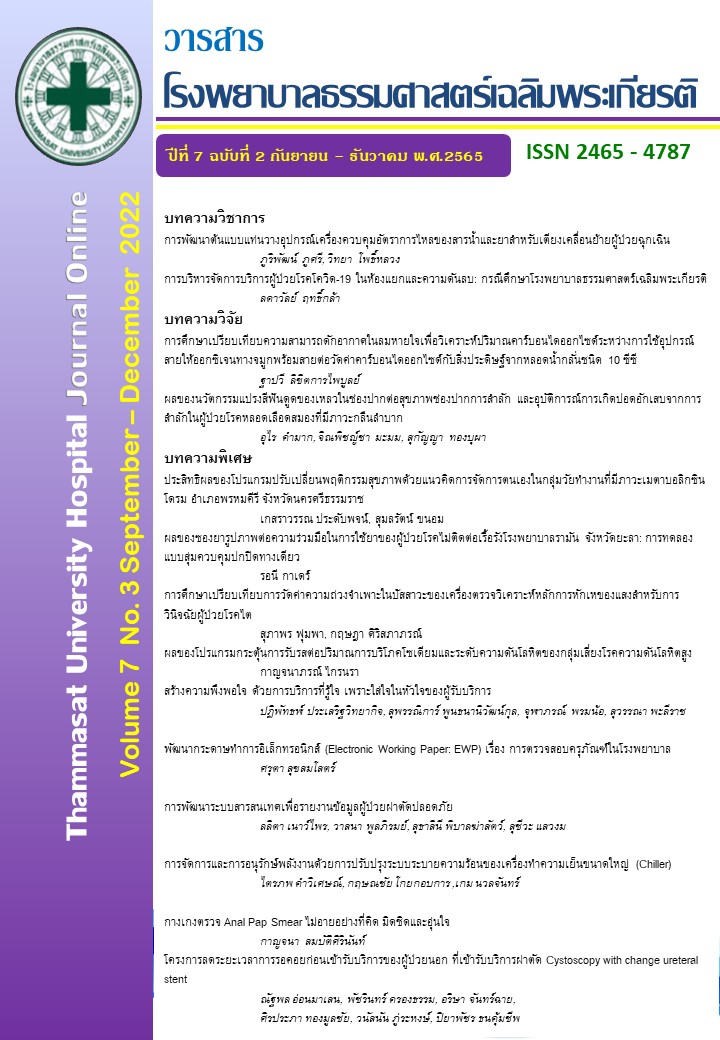The effects of oral liquid toothbrush innovation on oral hygiene aspiration and incidence of aspiration pneumonia among stroke patients with dysphagia
Keywords:
Stroke patients, oral hygiene care, oral hygiene, aspirate, aspiration pneumoniaAbstract
Background: Dysphagia is a common problem that is a leading cause of pneumonia in stroke patients. A review of research shows that oral hygiene care can reduce the incidence of aspiration pneumonia. Therefore, an innovation of oral liquid suction toothbrushes has been developed, together with oral hygiene care practices guideline to increase the efficiency of oral hygiene care, and decrease aspiration rate and the incidence of aspiration pneumonia in stroke patients.
Objective: To study the effects of oral liquid toothbrush innovation on oral hygiene, aspiration, and incidence of aspiration pneumonia among stroke patients with dysphagia
Material and methods: This study was a quasi-experimental research with pretest-posttest. The study recruited 190 persons with acute stroke admitted to a university hospital in Pathumthani province. The sample was assigned to the experimental group (n=95) and the control group (n=95). The collecting data was started in the control group until completed, then data was collected in the experimental group. The control group received usual oral hygiene care as oral hygiene care practice guideline, while the experimental group received oral hygiene care as oral hygiene care practic guideline with an innovation of oral liquid suction toothbrush. The instruments used in this study included the Demographic Questionnaire, Standardized Swallowing Assessment the Oral Assessment Guide (OAG), the Aspiration score, and the incidence of aspiration pneumonia. Data were analyzed using descriptive statistics and a t-test.
Result: The experimental group increased the mean score of OAG significantly more than the control group (p<0.001). The experimental group had lower significantly a mean score of the aspiration score and lower incidence of aspiration pneumonia than the control group (p<0.001).
Conclusion: The innovative oral liquid suction toothbrush can increase oral hygiene, decrease the incidence of aspiration and aspiration pneumonia in stroke patients with dysphagia.
References
Feigin VL, Stark BA, Johnson CO, Roth GA, Bisignano C, Abady GG, et al. Global, regional, and national burden of stroke and its risk factors, 1990–2019: A systematic analysis for the Global Burden of Disease Study 2019. Lancet Neurol. 2021;20(10):795-820.
Yuan Mz, Li F, Fang Q, Wang W, Peng Jj, Qin Dy, et al. Research on the cause of death for severe stroke patients. JCN. 2018;27(1-2):450-60.
Thammasat University Hospital. Statistics of stroke patients admitted to Thammasat Hospital. In: Unit S, editor. Thammasat University Hospital: Thammasat University Hospital; 2020.
Prendergast V, Hinkle JL. Oral care assessment tools and interventions after stroke. Stroke. 2018;49(4):e153-e6.
Rofes L, Muriana D, Palomeras E, Vilardell N, Palomera E, Alvarez‐Berdugo D, et al. Prevalence, risk factors and complications of oropharyngeal dysphagia in stroke patients: a cohort study. Neurogastroenterol Motil. 2018;30(8):e13338.
กนกพรรณ งามมุข, ศศิมา กุสุมา ณ อยุธยา, วันเพ็ญภิญโญภาสกุล. การดูแลความสะอาดช่องปากในผู้ป่วยวิกฤตเพื่อป้องกันการติดเชื้อปอดอักเสบจากการใช้เครื่องช่วยหายใจ: การพยาบาลตามหลักฐานเชิงประจักษ. วชิรสารการพยาบาล. 2559;18(2):1-11.
ตระการตา แซ่ฉั่ว, มลฤดี คงวัฒนานนท์ ,ใจรพร บัวทอง, สุพรพรรณ์ กิจบรรยงเลิศ, วงจันทร์ เพชรพิเชฐเชียร. ประสิทธิผลของโปรแกรมการดูแลองปากต่อสุขภาพองปากและการเกิดปอดอักเสบจากการเครื่องวยหายใจในผู้ป่วยวิกฤติ: การทดลองแบบสุ่มและมีกลุ่มควบคุม. วารสารสภาการพยาบาล. 2561;33(4):46-63.
Mandell LA, Niederman MS. Aspiration pneumonia. NEJM. 2019;380(7):651-63.
Matsumoto-Nakano M. Role of Streptococcus mutans surface proteins for biofilm formation. Jpn Dent Sci Rev. 2018;54(1):22-9.
Mitchell BG, Russo PL, Cheng AC, Stewardson AJ, Rosebrock H, Curtis SJ, et al. Strategies to reduce non-ventilator-associated hospital-acquired pneumonia: A systematic review. Infect Dis Health. 2019;24(4):229-39.
Lyons M, Smith C, Boaden E, Brady MC, Brocklehurst P, Dickinson H, et al. Oral care after stroke: Where are we now?. Eur Stroke J. 2018;3(4):347-54.
Lam OL, McGrath C, Li LS, Samaranayake LP. Effectiveness of oral hygiene interventions against oral and oropharyngeal reservoirs of aerobic and facultatively anaerobic gram-negative bacilli. Am J Infect Control. 2012;40(2):175-82.
Li S, Chen Y-T, Francisco GE, Zhou P, Rymer WZ. A unifying pathophysiological account for post-stroke spasticity and disordered motor control. Front Neurol. 2019;10:468.
Murray J, Scholten I. An oral hygiene protocol improves oral health for patients in inpatient stroke rehabilitation. Gerodontology. 2018;35(1):18-24.
Bangee M, Martinez-Garduno CM, Brady MC, Cadilhac DA, Dale S, Hurley MA, et al. Oral care practices in stroke: findings from the UK and Australia. BMC nursing. 2021;20(1):1-8.
Shukla N, Saha S, Singh S. Effect of chlorhexidine with fluoride mouthrinse on plaque accumulation, plaque pH-a double blind parallel randomized clinical trial. J Clin Diagn Res. 2016;10(7):ZC62.
Castillo DH, Smith DJ, Rosenfeld P. Implementing and evaluating the impact of a nurse-led oral care initiative. J Nurs Care Qual. 2020;35(2):123-9.
Dai R, Lam OL, Lo EC, Li LS, McGrath C. A randomized clinical trial of oral hygiene care programmes during stroke rehabilitation. J Dent. 2017;61:48-54.
อุไร คำมาก, ศุภชัย รักแก้ว, ปิยรัตน์ อินทโชติ, ศิรินทิยา พูลโคก, ปียานุช ลาหล้าเลิศ, วรรณพรรณ สาสุขวัฒน์, ธณาวดี สุขสวัสดิ์. โปรแกรมการดูแลสุขภาพช่องปากในผู้ป่วยโรคหลอดเลือดสมองที่มีภาวะกลืนลำบาก: การทบทวนอย่างเป็นระบบ. วารสารโรงพยาบาลธรรมศาสตร์เฉลิมพระเกียรติ. 2565;7(1):57-73.
อุไร คำมาก, สุกัญญา ทองบุผา, ยุวดี บุตรเอก, ปราณปริยา อุทัย, กนิษฐา สุวรรณรัตน์, ดวงกมล เคนตู้. การดูแลสุขภาพช่องปากผู้ป่วยโรคหลอดเลือดสมองเพื่อป้องกันภาวะปอดอักเสบ: หลักฐานเชิงประจักษ์. วารสารโรงพยาบาลธรรมศาสตร์เฉลิมพระเกียรติ. 2565;7(1):46-56.
Andersson P, Hallberg IR, Renvert S. lnter‐rater reliability of an oral assessment guide for elderly patients residing in a rehabilitation ward. Spec Care Dentist. 2002;22(5):181-6.
วันทกานต์ ราชวงศ์, ปรางทิพย์ ฉายพุทธ, สุวิมล กิมปี, นันทกานต์ เอี่ยมวนานนทชัย. ผลของโปรแกรมการจัดการการดูแลช่องปากด้วยตนเองต่อภาวะเยื่อบุช่องปากอักเสบในผู้ป่วยมะเร็งศีรษะและคอที่ได้รับการรักษาด้วยการฉายรังสีหรือฉายรังสีร่วมกับยาเคมีบำบัด. วารสารสภาการพยาบาล. 2556;28(1):34-48.
Stewart S, Robertson C, Pan J, Kennedy S, Haahr L, Manoukian S, et al. Impact of healthcare-associated infection on length of stay. J Hosp Infect. 2021;114:23-31.
Downloads
Published
How to Cite
Issue
Section
License
Copyright (c) 2022 Thammasat University Hospital Journal Online

This work is licensed under a Creative Commons Attribution-NonCommercial-NoDerivatives 4.0 International License.



